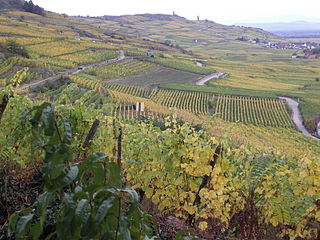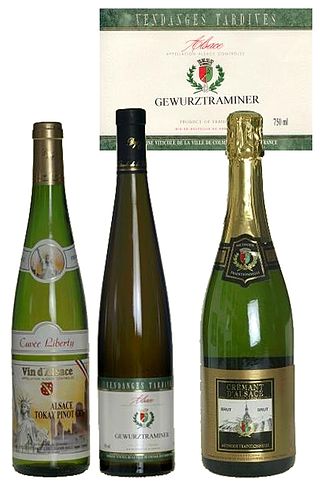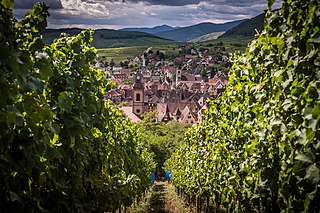
Alsace wine or Alsatian wine is produced in the Alsace region in France and is primarily white wine. Because of its Germanic influence, it is the only Appellation d'Origine Contrôlée region in France to produce mostly varietal wines, typically from similar grape varieties to those used in German wine. Along with Austria and Germany, it produces some of the most noted dry Rieslings in the world as well as highly aromatic Gewürztraminer wines. Wines are produced under three different AOCs: Alsace AOC for white, rosé and red wines, Alsace Grand Cru AOC for white wines from certain classified vineyards and Crémant d'Alsace AOC for sparkling wines. Both dry and sweet white wines are produced.

Vendange tardive ("VT") means "late harvest" in French. The phrase refers to a style of dessert wine where the grapes are allowed to hang on the vine until they start to dehydrate. This process, called passerillage, concentrates the sugars in the juice and changes the flavours within it. The name is sometimes written as the plural form, vendanges tardives, referring to the fact that several runs through the vineyard are often necessary to produce such wines. In other countries such as Germany or Austria the term Spätlese is used to describe wine using the same making process.
The glossary of wine terms lists the definitions of many general terms used within the wine industry. For terms specific to viticulture, winemaking, grape varieties, and wine tasting, see the topic specific list in the "See also" section below.

Maison Joseph Drouhin is a French wine producer based in Burgundy that was founded in 1880. The estate owns vineyards in Chablis, the Côte de Nuits, Côte de Beaune and Côte Chalonnaise, as well as in the Willamette Valley in Oregon. Drouhin is also one of the major négociants of Burgundy, and produces wines made from purchased grapes grown in different parts of Burgundy. Today both Maison Joseph Drouhin and Domaine Drouhin Oregon are owned and operated by the great-grandchildren of Joseph Drouhin.
Sélection de Grains Nobles (SGN) is French for "selection of noble berries" and refers to wines made from grapes affected by noble rot. SGN wines are sweet dessert wines with rich, concentrated flavours. Alsace wines were the first to be described as Sélection de Grains Nobles, with the legal definition introduced in 1984, but the term is also seen in some other wine regions France, such as Loire.

Luxembourgish wine is primarily produced in the southeastern part of the Grand Duchy of Luxembourg, with vineyards overlooking the river Moselle. Along this river, which for 42 km makes up part of the border between Luxembourg and Germany, wine is made in three countries. There is a continuous history of winemaking along Moselle and in Luxembourg going back to Ancient Roman times. Wine production in 2006/07 was 123,652 hectoliter from 1,237 hectares of vineyards. Out of total wine exports of 87,776 hectoliter in 2005/06, 71,726 hectoliter or 82% was exported to nearby Belgium. Exports to Germany were the second largest at 8,168 hectoliter, or 9%, and is to a large extent made up of base wine in bulk for the production of blended Sekt rather than being sold bottled with "Luxembourg" anywhere on the label. Therefore, very little Luxembourgish wine is seen outside Luxembourg and Belgium.

Jean "Johnny" Frederic Hugel was an Alsatian wine producer, described by wine expert Tom Stevenson as "the single most important person in the development of Alsace wine industry throughout the 20th century."

Domaine Zind-Humbrecht is a winery located in Turckheim, Alsace, France.

The wine region of Alsace produces wines under three different Appellations d'Origine Contrôlées (AOCs): Alsace AOC for white, rosé and red wines, Alsace Grand Cru AOC for white wines from certain classified vineyards and Crémant d'Alsace AOC for sparkling wines. This region is the only French wine region allowed to label its wines based on variety.
Marcel Deiss is a French wine grower and producer. It is based in Bergheim, in the Alsace wine region of France.

The Alsatian Grand Cru vineyard Schoenenbourg is situated north of the village Riquewihr. The vineyard faces south and south-east on the steep hill Schoenenbourg. The altitude of the vines are between 265 and 380 meters and covers 53.4 ha og Keuper subsoil with marl, gypsum and dolomite.
The Alsace Grand Cru Hengst, or Hengst, is a French wine originating in the commune of Wintzenheim, in the département of Haut-Rhin, in Alsace. While historically almost solely made up by white wines, a small amount of production is now Grand Cru red wine, solely from Pinot Noir grapes.

Alsace Grand Cru Altenberg de Bergheim, or Altenberg-de-Bergheim is a French white wine produced in the Altenberg lieu-dit, located in the commune of Bergheim, in the Haut-Rhin department, in Alsace.

Alsace Grand Cru Altenberg de Wolxheim, or altenberg-de-wolxheim is a French white wine produced in the Altenberg lieu-dit, located in the commune of Wolxheim, in the Haut-Rhin department, in Alsace.

Alsace Grand Cru Brand is a French white wine produced in the Haut-Rhin department, in Alsace.

Bruderthal is an Alsace Grand Cru French white wine from the village of Molsheim produced in the Bas-Rhin department, in Alsace.

Alsace Grand Cru Eichberg is a French white wine produced in the Haut-Rhin department, in Alsace. On the Alsace Wine Route, Eichberg is located six kilometres southwest of Colmar. In terms of the Alsace vineyards it lies between Pfersigberg to the north and Hatschbourg to the south. It is one of the fifty-one grands crus of the Alsace region, each enjoying its own appellation but sharing the same Alsace Grand Cru specifications.
Alsace Grand Cru ‘’Engelberg’’ is a French white wine produced in the Bas-Rhin department, in Alsace.

Alsace Grand Cru Floriment is a French white wine produced in the Haut-Rhin department, in Alsace. It is a part of the communes of Ingersheim and Katzenthal.















